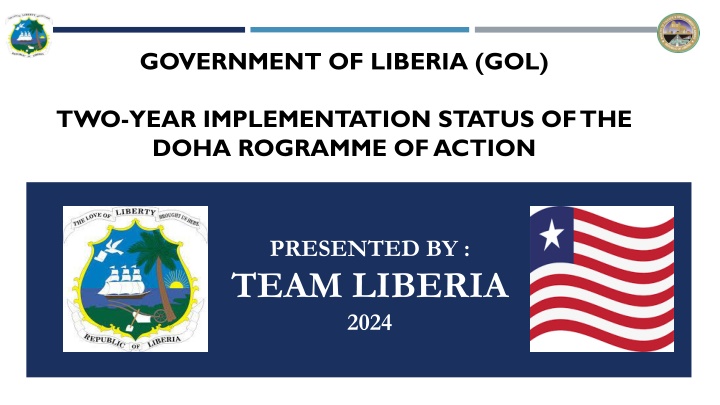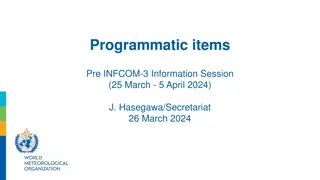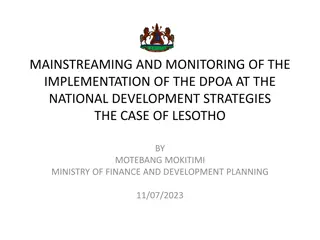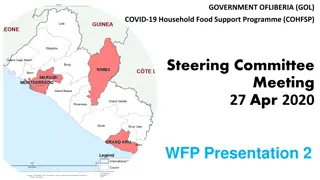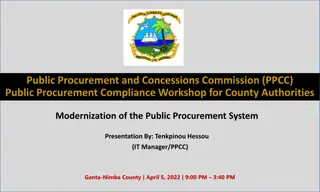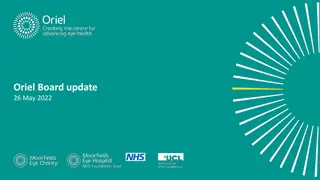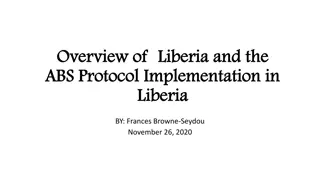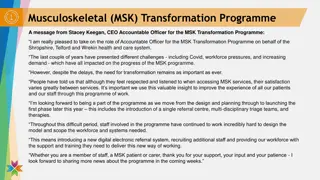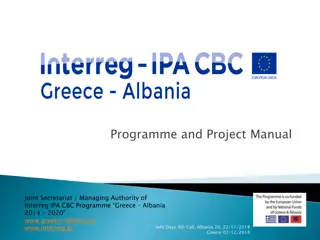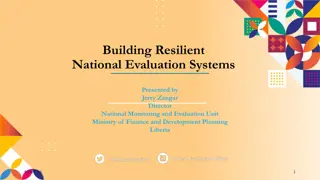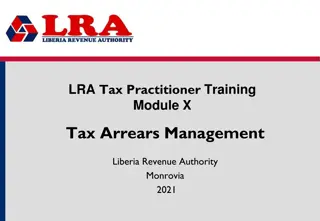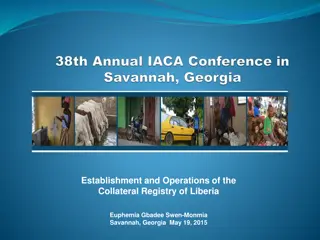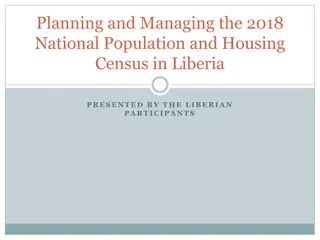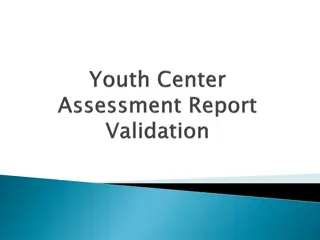Progress and Challenges in Implementing the Doha Programme of Action in Liberia
Liberia has made strides in its two-year implementation of the Doha Programme of Action, focusing on eradicating poverty, improving health indicators, and enhancing access to basic services. Challenges remain, including poverty rates, malnutrition, and sanitation issues. Recommendations include further investment in people and capacity building to ensure sustainable development.
Download Presentation

Please find below an Image/Link to download the presentation.
The content on the website is provided AS IS for your information and personal use only. It may not be sold, licensed, or shared on other websites without obtaining consent from the author.If you encounter any issues during the download, it is possible that the publisher has removed the file from their server.
You are allowed to download the files provided on this website for personal or commercial use, subject to the condition that they are used lawfully. All files are the property of their respective owners.
The content on the website is provided AS IS for your information and personal use only. It may not be sold, licensed, or shared on other websites without obtaining consent from the author.
E N D
Presentation Transcript
GOVERNMENT OF LIBERIA (GOL) TWO-YEAR IMPLEMENTATION STATUS OF THE DOHA ROGRAMME OF ACTION PRESENTED BY : TEAM LIBERIA 2024
OUTLINE Brief Overview of Liberia Implementation Status Challenges Recommendation
OVERVIEW OF LIBERIA Liberia is located on the West Coast of Africa One of the two African countries never colonized Declared its independence in 1847 Population is 5.4 Million Two Seasons Wet and Dry 3 Endowed with many resources (Gold, Diamond, Iron ore, Marine Resources)
INVESTING IN PEOPLE IN LEAST DEVELOPED COUNTRIES: ERADICATING POVERTY AND BUILDING CAPACITY TO LEAVE NO ONE BEHIND; GDP increased from -3% (2020) to 3.7% in 2021, and was projected to further increase to 4.7% in 2023 The proportion of Liberians below the international poverty line is 51.5% (2023) Poverty & growth increasing from 49.4% in 2019. Liberia s hunger index value has declined slightly from an alarming situation of 35 in 2012 to a serious situation of 32.3 in 2023 respectively. (Liberia - Global Hunger Index 2023) Prevalence of malnutrition among children under five years of age: Wasting ( thinness) decreased from 6% in 2013 to 3% in 2019/2020, 4 Overweight children increased from 3% in 2013 to 4% in 2019/2020.
INVESTING IN PEOPLE IN LEAST DEVELOPED COUNTRIES: ERADICATING POVERTY AND BUILDING CAPACITY TO LEAVE NO ONE BEHIND; The Maternal mortality ratio declined from 1072 to 742 per 100,000 live births. This represents a 31% reduction, comparing 2013 to 2019/20 Health and Sanitation Neonatal mortality rate increased from 26 per 1000 live births in 2013 to 37 per 1000 live births in 2019/2020. Delivery in health facility have increased from 76% in 2019/2020 to 80% (LDHS 2019/20); Delivering at home has declined by 17.4% between 2019/2020. Under-five mortality reduced from 94 death per 1,000 live births in 2013 to 85 deaths per 1000 live births in 2019/2020. 5 DATA SOURCE FOR HEALTH AND OTHER INDICATORS: LIBERIA DEMOGRAPHY AND HEALTH STATISTICS WHICH IS CONDUCTED EVERY FIVE YEARS. ( DATA USED IS FROM 2019/2020)
INVESTING IN PEOPLE IN LEAST DEVELOPED COUNTRIES: ERADICATING POVERTY AND BUILDING CAPACITY TO LEAVE NO ONE BEHIND; Access to basic drinking water increased from 73% in 2022 to 85% 2024; The overall percentage of households with an improved source of drinking water has increased over time from 68% in 2022 to 84% in 2024 Health and Sanitation The population practicing Open Defecation reduced from 42% in 2020 to 34% 2024 The percentage of households with access to improved sanitation increased from 47% in 2019-20. to 68% in 2023
INVESTING IN PEOPLE IN LEAST DEVELOPED COUNTRIES: ERADICATING POVERTY AND BUILDING CAPACITY TO LEAVE NO ONE BEHIND; Tuition-free policy for all public school (primary to tertiary) Education Similarly, there the ratio of female to male enrollment has increased overtime
INVESTING IN PEOPLE IN LEAST DEVELOPED COUNTRIES: ERADICATING POVERTY AND BUILDING CAPACITY TO LEAVE NO ONE BEHIND; Liberia s National Gender Policy serves as the framework for promoting gender equality in Liberia. Significant improvements have been made for women to serve in leadership positions. For example, the current Senate Pro-Tempore is a female, and three out of the five Gender inclusion Justices on the Supreme Court bench are females. Similarly, women hold 15.8% of Cabinet posts, 24.5% of Deputy Ministerial positions, and 25.9% of assistant ministerial positions.
LEVERAGING THE POWER OF SCIENCE, TECHNOLOGY, AND INNOVATION TO FIGHT AGAINST MULTIDIMENSIONAL VULNERABILITIES AND TO ACHIEVE THE SUSTAINABLE DEVELOPMENT GOALS; 3. In terms of Active mobile money accounts out of everyone thousand adults, (1,000 adults) 847 have mobile accounts. And this is promoting economic activity. 2. Mobile Connectivity Index: Affordability: Handset affordability, Dimension component score (0-100, higher is better) 35.17 1. Percentage of individuals using the internet is 30.13 which puts Liberia at the rank of 33/49 countries. 9 LIBERIA INFORMATION AND COMMUNICATIONS TECHNOLOGY (ICT) - COUNTRY DASHBOARD - ALL (USAID.GOV) IN 2022 INTERNET ACCESS WAS 20%. IT HAS INCREASED TO 30. 13
MOBILIZING INTERNATIONAL SOLIDARITY, REINVIGORATED GLOBAL PARTNERSHIPS AND INNOVATIVE TOOLS AND INSTRUMENTS: A MARCH TOWARDS SUSTAINABLE GRADUATION. Forging bilateral and multilateral partnerships across the globe Liberia is a member of the Mano River Union, the Economic Community of West Africa States, the WTO and the African Union. 10
CHALLENGES Liberia still has challenges in the following areas : Inadequate industrial policy for supporting structural change The Country still depends on extractive industry for its economic growth, which is not sustainable. Liberia is highly susceptible to the impacts of climate change Liberia still grapples high unemployment crisis especially among the youth 11
PROPOSED SOLUTIONS Improve the country s macro and fiscal stability Invest in agriculture to combat poverty and confront climate change More Investment in human capital Need for more investment in industrial development of Liberia 12
THANK YOU 13
